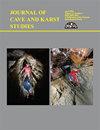Stimulation of Aquatic Bacteria from Mammoth Cave, Kentucky, by Sublethal Concentrations of Antibiotics
IF 0.5
4区 地球科学
Q4 GEOSCIENCES, MULTIDISCIPLINARY
引用次数: 0
Abstract
Many microorganisms secrete secondary metabolites with antibiotic properties; however, there is debate whether the secretions evolved as a means to gain a competitive edge or as a chemical signal to coordinate community growth. The objective of this research was to investigate if select antibiotics acted as a weapon or as a chemical signal by exposing communities of aquatic cave bacteria to increasing concentrations of antibiotics. Water samples were collected from six cave locations where actinobacterial mats appeared to be plentiful. Bacterial growth was measured using colony counts on 10 % tryptic soy agar augmented with increasing concentrations of erythromycin, tetracycline, kanamycin, gentamicin, or quaternary ammonia compounds (QAC). Colony counts generally decreased as the gentamicin, kanamycin and QAC dose increased. In contrast, the colony numbers increased on agar plates supplemented with 0.01 mg L−1, 0.10 mg L−1 and 1.00 mg L−1 erythromycin or tetracycline. A 10.00 mg L−1 dose of each antibiotic treatment reduced bacteria colonies by 98 % or more. Community-level physiological capabilities were evaluated using Ecolog plates inoculated with cave water dosed with either 0.00 mg L−1 or 0.10 mg L−1 of erythromycin. Incubation with the antibiotic almost doubled the number of food substrates used in the first 24 hours. There was a significant increase in the use of acetyl glucosamine, arginine, and putrescine when bacteria were exposed to 0.10 mg L−1 erythromycin triggered by the antibiotic acting as a chemical messenger. Principal component analysis confirmed a shift in substrate preferences when erythromycin was added. A conceptual ecological model is proposed based on the response of aquatic cave bacteria to sublethal antibiotics.亚致死浓度抗生素对肯塔基猛犸洞水生细菌的刺激作用
许多微生物分泌具有抗生素特性的次生代谢物;然而,这种分泌物是作为一种获得竞争优势的手段,还是作为一种协调群落生长的化学信号,一直存在争议。本研究的目的是通过将水生洞穴细菌群落暴露于浓度不断增加的抗生素中,调查选定的抗生素是作为武器还是作为化学信号。从放线菌群丰富的六个洞穴地点收集了水样。在10%的胰大豆琼脂上,通过增加红霉素、四环素、卡那霉素、庆大霉素或季氨化合物(QAC)的浓度,使用菌落计数来测量细菌生长。随着庆大霉素、卡那霉素和QAC剂量的增加,菌落计数普遍减少。而在添加0.01 mg L−1、0.10 mg L−1和1.00 mg L−1红霉素或四环素的琼脂平板上,菌落数量增加。每次抗生素治疗剂量为10.00 mg L−1时,细菌菌落减少98%或更多。用生态板接种含有0.00 mg L−1或0.10 mg L−1红霉素的洞穴水,评估社区水平的生理能力。在最初的24小时内,用抗生素孵育的食物基质数量几乎增加了一倍。当细菌暴露于由抗生素作为化学信使触发的0.10 mg L−1红霉素时,乙酰氨基葡萄糖、精氨酸和腐胺的使用显著增加。主成分分析证实,当添加红霉素时,底物偏好发生了变化。提出了一种基于水生洞穴细菌对亚致死抗生素反应的概念生态模型。
本文章由计算机程序翻译,如有差异,请以英文原文为准。
求助全文
约1分钟内获得全文
求助全文
来源期刊

Journal of Cave and Karst Studies
地学-地球科学综合
CiteScore
1.90
自引率
0.00%
发文量
6
审稿时长
>12 weeks
期刊介绍:
The Journal of Cave and Karst Studies is a multidisciplinary journal devoted to cave and karst research. The Journal is seeking original, unpublished manuscripts concerning the scientific study of caves or other karst features. Authors do not need to be members of the National Speleological Society, but preference is given to manuscripts of importance to North American speleology.
 求助内容:
求助内容: 应助结果提醒方式:
应助结果提醒方式:


